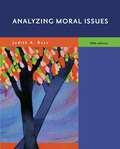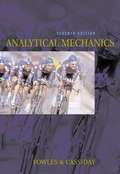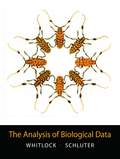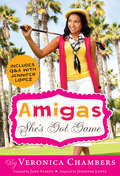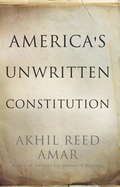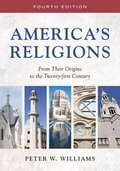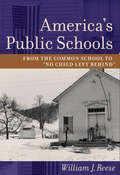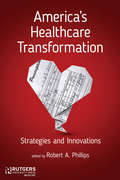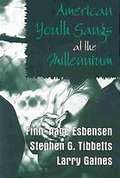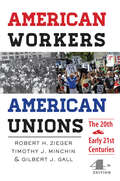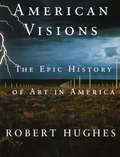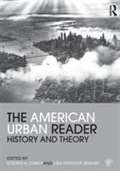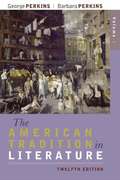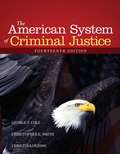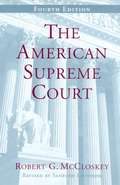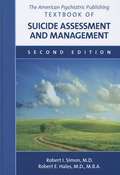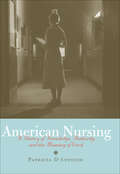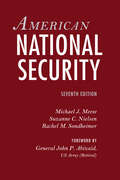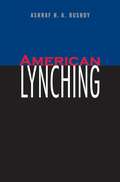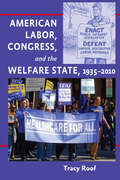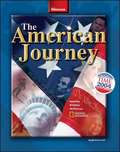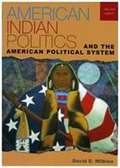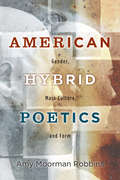- Table View
- List View
Analyzing Narrative: Discourse and Sociolinguistic Perspectives
by Anna De Fina Alexandra GeorgakopoulouThe socially minded linguistic study of storytelling in everyday life has been rapidly expanding. This book provides a critical engagement with this dynamic field of narrative studies, addressing long-standing questions such as definitions of narrative and views of narrative structure but also more recent preoccupations such as narrative discourse and identities, narrative language, power and ideologies. It also offers an overview of a wide range of methodologies, analytical modes and perspectives on narrative from conversation analysis to critical discourse analysis, to linguistic anthropology and ethnography of communication. The discussion engages with studies of narrative in multiple situational and cultural settings, from informal-intimate to institutional. It also demonstrates how recent trends in narrative analysis, such as small stories research, positioning analysis and sociocultural orientations, have contributed to a new paradigm that approaches narratives not simply as texts, but rather as complex communicative practices intimately linked with the production of social life.
Analyzing Moral Issues (5th edition)
by Judith A. BossThis text with readings addresses a variety of timely and interesting moral issues, providing background information and primary source selections for each issue presented. It includes a chapter on ethical theory and covers a broad range of ethical perspectives--among them virtue ethics (Aristotelian and Confucian), Buddhist and feminist care ethics, and the Rawlsian and communitarian approaches. The fifth edition also includes new readings and case studies covering some of the more pressing issues of recent ethical debate, such as genetic enhancement of children, racism and sexism in the 2008 presidential elections, the effect of the U. S. Patriot Act on academic freedom, military conscription, and global warming.
Analytical Mechanics (Seventh Edition)
by Grant R. Fowles George L. CassidayThis textbook is intended for an undergraduate course in classical mechanics taken by students majoring in physics, physical science, or engineering.
The Analysis of Biological Data: From Mind to Molecules
by Michael Whitlock Dolph SchluterThe Analysis of Biological Data is a new approach to teaching introductory statistics to biology students. To reach this unique audience, Whitlock and Schluter motivate learning with interesting biological and medical examples; they emphasize intuitive understanding; and they focus on real data. The book covers basic topics in introductory statistics, including graphs, confidence intervals, hypothesis testing, comparison of means, regression, and designing experiments. It also introduces the principles behind such modern topics as likelihood, linear models, meta-analysis and computer-intensive methods. Instructors and students consistently praise the book's clear and engaging writing, strong visualization techniques, and its variety of fascinating and relevant biological examples.
Amigas She's Got Game (Amigas #3)
by Veronica ChambersAmigas have definitely arrived. Fresh out of the spotlight of their first television experience, the team is back and stronger than ever. But the heat is always on in Miami and when they get hired to do an unusual quince for a bratty debutante, the temperature goes sky high. As Alicia and her friends try to figure out how to throw a party for Miss Perfect, Jamie finds herself in a new situation--a romantic one! Turns out the debutante's brother is a total prince. But the prince is from a completely different world. Will Jamie be able to push aside her doubts and get swept off her feet? And will the Amigas perfect track record take a hit with a client who is NEVER happy?
America's Unwritten Constitution: The Precedents and Principles We Live By
by Akhil Reed AmarDespite its venerated place atop American law and politics, our written Constitution does not enumerate all of the rules and rights, principles and procedures that actually govern modern America. The document makes no explicit mention of cherished concepts like the separation of powers and the rule of law. On some issues, the plain meaning of the text misleads. For example, the text seems to say that the vice president presides over his own impeachment trial-but surely this cannot beright. As esteemed legal scholar Akhil Reed Amar explains inAmerica’s Unwritten Constitution, the solution to many constitutional puzzles lies not solely within the written document, but beyond it-in the vast trove of values, precedents, and practices that complement and complete the terse text. In this sequel toAmerica’s Constitution: A Biography, Amar takes readers on a tour of our nation’sunwrittenConstitution, showing how America’s foundational document cannot be understood in textual isolation. Proper constitutional interpretation depends on a variety of factors, such as the precedents set by early presidents and Congresses; common practices of modern American citizens; venerable judicial decisions; and particularly privileged sources of inspiration and guidance, including theFederalistpapers, William Blackstone’sCommentaries on the Laws of England, the Northwest Ordinance of 1787, Lincoln’s Gettysburg Address, and Martin Luther King, Jr. ’s "I Have a Dream” speech. These diverse supplements are indispensible instruments for making sense of the written Constitution. When used correctly, these extra-textual aids support and enrich the written document without supplanting it. An authoritative work by one of America’s preeminent legal scholars,America’s Unwritten Constitutionpresents a bold new vision of the American constitutional system, showing how the complementary relationship between the Constitution’s written and unwritten components is one of America’s greatest and most enduring strengths.
America's Religions: From Their Origins to the Twenty-first Century (3rd edition)
by Peter W. WilliamsIn this comprehensive survey, Williams offers concise descriptions of the background, beliefs, practices, and leaders of America's most influential and distinctive religious movements and denominations. Thoroughly revised and updated, this third edition of America's Religions incorporates the latest scholarship on religion and considers timely issues such as status of Muslims in the United States after September 11, 2001; the impact of religion on American politics, especially concerning the emergence of the Religious Right; and the intense battles fought within the Catholic Church and other denominations over the status of gay marriage and accusations of clergy members' sexual abuse. This edition also includes thirty-eight new illustrations of key persons in American religious history and notable places of worship.
America's Public Schools: From the Common School to "No Child Left Behind" (The American Moment)
by William J. ReeseIn this update to his landmark publication, William J. Reese offers a comprehensive examination of the trends, theories, and practices that have shaped America’s public schools over the last two centuries. Reese approaches this subject along two main lines of inquiry—education as a means for reforming society and ongoing reform within the schools themselves. He explores the roots of contemporary educational policies and places modern battles over curriculum, pedagogy, race relations, and academic standards in historical perspective.A thoroughly revised epilogue outlines the significant challenges to public school education within the last five years. Reese analyzes the shortcomings of "No Child Left Behind" and the continued disjuncture between actual school performance and the expectations of government officials. He discusses the intrusive role of corporations, economic models for enticing better teacher performance, the continued impact of conservatism, and the growth of home schooling and charter schools. Informed by a breadth of historical scholarship and based squarely on primary sources, this volume remains the standard text for future teachers and scholars of education.
America's Healthcare Transformation: Strategies and Innovations
by Sandra A. Weiss Nikhil G. Thaker Arthur Tim" Garson Thomas H. Lee David W. Bates Hanh H. Hoang Philip Greenland Tine Hansen-Turton Sarah Slight James L. Field Susan A. Abookire Thomas W. Feeley Amir Rubin Janet J. Teske Julia D. Andrieni Alicia D.H. Monroe Kenneth Patric Steven R. Steinhubl Elizabeth Malcolm Nana Ekua Coleman Mark R. Chassin William S. Weintraub Kasey R. Boehmer Arnold Milstein Sharyl Wojciechowski Marc L. Boom Victor M. Montori Henry H. Ting Ju Young Kim Erin S. Dupree Gary S. Kaplan Mauro Ferrari Jason Gorevic Kasaiah Makam Kunal N. Karmali Alberta T. Pedroja Dr Robert A. Phillips Deirde MylodA revolution in American medicine is in full swing, with the race from fee-for-service to fee-for-value at the front line in an epic battle that will transform healthcare delivery for decades to come. In America's Healthcare Transformation, eminent physician leader Robert A. Phillips brings together key thought leaders and trail-blazing practitioners, who provide a wide-ranging exploration of the strategies, innovations, and paradigm shifts that are driving this healthcare transformation. The contributors offer a panoramic look at the dramatic changes happening in the field of medicine, changes that put the patient at the heart of the process. Among other subjects, the essays evaluate innovative high quality and low cost care delivery solutions from around the United States and abroad, describe fundamental approaches to measuring the safety of care and the impact that guidelines have on improving quality of care and outcomes, and make a strong case that insurance reform will fundamentally and irreversibly drive delivery reform. In addition, America's Healthcare Transformation reviews the role of health information technology in creating safer healthcare, provides a primer on the development of a culture of safety, and highlights ground-breaking new ways to train providers in patient safety and quality. Finally, the book looks at reports from Stanford Health Care and Houston Methodist which outline how successful behaviorally based strategies, anchored in values, can energize and empower employees to deliver a superior patient experience. Drawing on the wisdom and vision of today's leading healthcare innovators, America's Healthcare Transformation provides a roadmap to the future of American healthcare. This book is essential reading for all health care providers, health care administrators, and health policy professionals, and it will be an invaluable resource in the effort to improve the practice of medicine and the delivery of healthcare in our communities and nation.
American Youth Gangs at the Millennium
by Finn-Aage Esbensen Stephen G. Tibbetts Larry GainesFor generations, scholars, law enforcement personnel, politicians, and the media have tried to understand and explain youth gangs and violence. This insightful collection contains the work of leading scholars, integrating previously published articles with new material to provide the most comprehensive information about the status of American youth gangs. The contributors attempt to answer crucial questions for understanding gangs: What is a gang? What are the risk factors associated with joining a gang? What is the nature of gang violence? How involved are girls in gangs and gang violence? The contributors¿ multifaceted approach to these questions and their ensuing discussions describe the varied and individual responses to gang violence. The topics are grouped in four sections: The first section explores the issues and ramifications of current terminology and survey information. In the second section, nontraditional gangs, such as female gangs and hybrid gangs, are discussed. The third section attempts to examine gang activities objectively and place them in a proper perspective. The final section looks at historical and current response techniques to youth gangs, such as suppression, prevention, and legal injunctions.
American Workers, American Unions: The Twentieth and Early Twenty-First Centuries (The American Moment)
by Robert H. Zieger Timothy J. Minchin Gilbert J. GallAn update to the classic history of labor and unions for a post-9/11 world.Highly acclaimed and widely read since its first publication in 1986, American Workers, American Unions provides a concise and compelling history of American workers and their unions in the twentieth century and the first decade of the twenty-first. Taking into account recent important work on the 1970s and the Reagan revolution, the fourth edition newly considers the stagflation issue, the rise of globalization and big box retailing, the failure of Congress to pass legislation supporting the right of public employees to collective bargaining, the defeat in Congress of legislation to revise the National Labor Relations Act, the emasculation of the Humphrey-Hawkins Act, and the changing dynamics of blue-collar politics. In addition to important new information on the 1970s and 1980s, the fourth edition contains a completely new final chapter. Largely written by Timothy J. Minchin, this chapter provides a rare survey of American workers and their unions between 9/11 and the 2012 presidential election. Gilbert J. Gall presents new information on government workers and their recent battles to defend workplace rights.
American Wings: Chicago's Pioneering Black Aviators and the Race for Equality in the Sky
by Sherri L. Smith Elizabeth WeinFrom the acclaimed author of Flygirl and the bestselling author of Code Name Verity comes the thrilling and inspiring true story of the desegregation of the skies.&“This beautiful and brilliant history of not only what it means to be Black and dream of flying but to, against every odd, do so, completely blew me away.&” —Jacqueline Woodson, National Book Award Winner for Brown Girl DreamingIn the years between World War I and World War II, aviation fever was everywhere, including among Black Americans. But what hope did a Black person have of learning to fly in a country constricted by prejudice and Jim Crow laws, where Black aviators like Bessie Coleman had to move to France to earn their wings?American Wings follows a group of determined Black Americans: Cornelius Coffey and Johnny Robinson, skilled auto mechanics; Janet Harmon Bragg, a nurse; and Willa Brown, a teacher and social worker. Together, they created a flying club and built their own airfield south of Chicago. As the U.S. hurtled toward World War II, they established a school to train new pilots, teaching both Black and white students together and proving, in a time when the U.S. military was still segregated, that successful integration was possible.Featuring rare historical photographs, American Wings brings to light a hidden history of pioneering Black men and women who, with grit and resilience, battled powerful odds for an equal share of the sky.
American Visions: The Epic History of Art in America
by Robert HughesWriting with all the brilliance, authority, and pungent wit that have distinguished his art criticism for Time magazine and his greatly acclaimed study of modern art, The Shock of the New, Robert Hughes now addresses his largest subject: the history of art in America. The intense relationship between the American people and their surroundings has been the source of a rich artistic tradition. American Visions is a consistently revealing demonstration of the many ways in which artists have expressed this pervasive connection. In nine eloquent chapters, which span the whole range of events, movements, and personalities of more than three centuries, Robert Hughes shows us the myriad associations between the unique society that is America and the art it has produced: "O My America, My New Founde Land" explores the churches, religious art, and artifacts of the Spanish invaders of the Southwest and the Puritans of New England; the austere esthetic of the Amish, the Quakers, and the Shakers; and the Anglophile culture of Virginia. "The Republic of Virtue" sets forth the ideals of neo-classicism as interpreted in the paintings of Benjamin West, John Singleton Copley, and the Peale family, and in the public architecture of Thomas Jefferson, Benjamin Latrobe, and Charles Bulfinch. "The Wilderness and the West" discusses the work of landscape painters such as Thomas Cole, Frederick Church, and the Luminists, who viewed the natural world as "the fingerprint of God''s creation," and of those who recorded America''s westward expansion--George Caleb Bingham, Albert Bierstadt, and Frederic Remington--and the accompanying shift in the perception of the Indian, from noble savage to outright demon. "American Renaissance" describes the opulent era that followed the Civil War, a cultural flowering expressed in the sculpture of Augustus Saint-Gaudens; the paintings of John Singer Sargent, Mary Cassatt, and Childe Hassam; the Newport cottages of the super-rich; and the beaux-arts buildings of Stanford White and his partners. "The Gritty Cities" looks at the post-Civil War years from another perspective: cast-iron cityscapes, the architecture of Louis Henri Sullivan, and the new realism of Thomas Eakins, Winslow Homer, the trompe-l''oeil painters, and the Ashcan School. "Early Modernism" introduces the first American avant garde: the painters Arthur Dove, Marsden Hartley, Joseph Stella, Charles Demuth, Charles Sheeler, and Georgia O''Keeffe, and the premier architect of his time, Frank Lloyd Wright. "Streamlines and Breadlines" surveys the boom years, when skyscrapers and Art Deco were all the rage . . . and the bust years that followed, when painters such as Edward Hopper, Stuart Davis, Thomas Hart Benton, Diego Rivera, and Jacob Lawrence showed Americans "the way we live now. " "The Empire of Signs" examines the American hegemony after World War II, when the Abstract Expressionists (Jackson Pollock, Willem de Kooning, Mark Rothko, et al. ) ruled the artistic roost, until they were dethroned by Jasper Johns, Robert Rauschenberg, the Pop artists, and Andy Warhol, while individualists such as David Smith and Joseph Cornell marched to their own music. "The Age of Anxiety" considers recent events: the return of figurative art and the appearance of minimal and conceptual art; the speculative mania of the 1980s, which led to scandalous auction practices and inflated reputations; and the trends and issues of art in the 90s. Lavishly illustrated and packed with biographies, anecdotes, astute and stimulating critical commentary, and sharp social history, American Visions was originally published in association with a new eight-part PBS television series. Robert Hughes has called it "a love letter to America. " This superb volume, which encompasses and enlarges upon the series, is an incomparably entertaining and insightful contemplation of its splendid subject.
The American Urban Reader: History and Theory
by Steven H. Corey Lisa Krissoff BoehmThe American Urban Reader brings together the most exciting work on the evolution of the American city, from colonial settlement and western expansion to post-industrial cities and the growth of the suburbs. Each of the chronologically and thematically organized chapters includes thoughtfully selected scholarly essays from historians, social scientists and journalists, which are supplemented by relevant primary documents that offer more nuanced perspectives and convey the diversity and interdisciplinary nature of the study of the urban condition.
The American Tradition in Literature: Volume 2 (12th Edition)
by George Perkins Barbara Perkins James Phelan Elizabeth RenkerIn this twelfth edition, The American Tradition in Literature extends fifty years of leadership into a second half-century.
The American System of Criminal Justice, Fourteenth Edition
by George F. Cole Christopher E. Smith Christina DejongThis classic best seller examines criminal justice across several disciplines, presenting elements from criminology, sociology, law, history, psychology, and political science. Broad coverage of the facts, uncompromising scholarship, an engaging writing style, and compelling delivery of current events make THE AMERICAN SYSTEM OF CRIMINAL JUSTICE, now in its 14th Edition, one of the best books available for an in-depth look at the American criminal justice system.
The American Supreme Court (4th edition)
by Robert G. Mccloskey Sanford LevinsonIn this fourth edition, Sanford Levinson extends McCloskey's magisterial treatment to address the Court's most recent decisions, including its controversial ruling in Bush v. Gore and its expansion of sexual privacy in Lawrence v. Texas.
The American Psychiatric Publishing Textbook of Suicide Assessment and Management
by Robert I. Simon Robert E. HalesThe second edition of The American Psychiatric Publishing Textbook of Suicide Assessment and Management has been extensively updated and expanded to more thoroughly reflect the challenges clinicians face in assessing and managing suicide risk -- and ultimately in preventing tragedy. The number of chapters has been increased approximately 20%, from 28 to 34. In addition, 22 new chapter authors were recruited for the second edition, representing nearly half of the 50 authors from the first edition, to allow the reader to obtain a more varied and sometimes new point of view.
American Nursing: A History of Knowledge, Authority, and the Meaning of Work
by Patricia D'AntonioFirst Place, History and Public Policy, 2010 American Journal of Nursing Book of the Year AwardsThis new interpretation of the history of nursing in the United States captures the many ways women reframed the most traditional of all gender expectations—that of caring for the sick—to create new possibilities for themselves, to renegotiate the terms of some of their life experiences, and to reshape their own sense of worth and power. For much of modern U.S. history, nursing was informal, often uncompensated, and almost wholly the province of female family and community members. This began to change at the end of the nineteenth century when the prospect of formal training opened for women doors that had been previously closed. Nurses became respected professionals, and becoming a formally trained nurse granted women a range of new social choices and opportunities that eventually translated into economic mobility and stability. Patricia D'Antonio looks closely at this history—using a new analytic framework and a rich trove of archival sources—and finds complex, multiple meanings in the individual choices of women who elected a nursing career. New relationships and social and professional options empowered nurses in constructing consequential lives, supporting their families, and participating both in their communities and in the health care system. Narrating the experiences of nurses, D'Antonio captures the possibilities, power, and problems inherent in the different ways women defined their work and lived their lives. Scholars in the history of medicine, nursing, and public policy, those interested in the intersections of identity, work, gender, education, and race, and nurses will find this a provocative book.
American National Security
by Michael J. Meese Suzanne C. Nielsen Rachel M. SondheimerThis classic text provides a rich and nuanced discussion of American national security policymaking.American National Security remains the ideal foundational text for courses in national security, foreign policy, and security studies. Every chapter in this edition has been extensively revised, and the book includes discussion of recent security policy changes in the Trump administration. Highlights include:• An updated look at national security threats, military operations, and homeland security challenges • An analysis of the evolving roles of the president, Congress, the intelligence community, the military, and other institutions involved in national security• A revised consideration of the strengths, limitations, and employment of instruments of national power, including diplomacy, information, economic tools, and armed forces• An exploration of the economic and national security implications of globalization• An enhanced examination of the proliferation of transnational threats, including security challenges in space and in cyberspace• A new assessment of how international, political, and economic trends may change US leadership of the post–World War II international order• A comprehensive update on changing dynamics in key states and regions, including Russia, China, East Asia, the Middle East, South Asia, Europe, Sub-Saharan Africa, and Latin AmericaAn authoritative book that explains US national security policy, actors, and processes in a wide-ranging yet understandable way, American National Security addresses key issues, including challenges to the free and open international order, the reemergence of strategic competition among great powers, terrorism, economic and fiscal constraints, and rapid advances in information and technology.
American Lynching
by Ashraf H. RushdyA history of lynching in America over the course of three centuries, from colonial Virginia to twentieth-century Texas.After observing the varying reactions to the 1998 death of James Byrd Jr. in Texas, called a lynching by some, denied by others, Ashraf Rushdy determined that to comprehend this event he needed to understand the long history of lynching in the United States. In this meticulously researched and accessibly written interpretive history, Rushdy shows how lynching in America has endured, evolved, and changed in meaning over the course of three centuries, from its origins in early Virginia to the present day.&“A work of uncommon breadth, written with equally uncommon concision. Excellent.&” —N. D. B. Connolly, Johns Hopkins University&“Provocative but careful, opinionated but persuasive . . . Beyond synthesizing current scholarship, he offers a cogent discussion of the evolving definition of lynching, the place of lynchers in civil society, and the slow-in-coming end of lynching. This book should be the point of entry for anyone interested in the tragic and sordid history of American lynching.&” —W. Fitzhugh Brundage, author of Lynching in the New South: Georgia and Virginia, 1880-1930&“A sophisticated and thought-provoking examination of the historical relationship between the American culture of lynching and the nation&’s political traditions. This engaging and wide-ranging meditation on the connection between democracy, lynching, freedom, and slavery will be of interest to those in and outside of the academy.&” —William Carrigan, Rowan University&“In this sobering account, Rushdy makes clear that the cultural values that authorize racial violence are woven into the very essence of what it means to be American. This book helps us make sense of our past as well as our present.&” —Jonathan Holloway, Yale University
American Labor, Congress, and the Welfare State, 1935–2010
by Tracy RoofDespite achieving monumental reforms in the United States such as the eight-hour workday, a federal minimum wage, and workplace health and safety laws, organized labor’s record on much of its agenda has been mixed. Tracy Roof’s sweeping examination of labor unions and the American legislative process explains how this came to be and what it means for American workers.Tracing a 75-year arc in labor movement history, Roof discusses the complex interplay between unions and Congress, showing the effects of each on the other, how the relationship has evolved, and the resulting political outcomes. She analyzes labor’s success at passing legislation and pushing political reform in the face of legislative institutional barriers such as the Senate filibuster and an entrenched and powerful committee structure, looks at the roots and impact of the interdependent relationship between the Democratic Party and the labor movement, and assesses labor’s prospects for future progress in creating a comprehensive welfare state. Roof’s original investigation details the history, actions, and consequences of major policy battles over areas such as labor law reform and health care policy. In the process, she brings to light practical and existential questions for labor leaders, scholars, and policy makers.Although American labor remains a force within the political process, decades of steadily declining membership and hostile political forces pose real threats to the movement. Roof’s shrewd exploration of unions, Congress, and the political process challenges conventional explanations for organized labor’s political failings.
The American Journey
by Mcgraw-Hill StaffThe complete story of American history in one comprehensive middle school program The American Journeyis a student-friendly presentation of American history from pre-exploration to the present. Its unparalleled author team, including National Geographic, ensures accuracy in every detail of the narrative, maps, and charts. This program emphasizes skill development--from reading maps to analyzing primary and secondary sources to exploring the connections between history and geography, economics, government, citizenship, and current events.
American Indian Politics and the American Political System (2nd edition)
by David E. WilkinsIn this college textbook, Wilkins (American Indian studies, political science, law, and American studies, U. of Minnesota) considers the relationship of American Indian governments to the American political system with emphasis on the sovereignty of tribal nations. He analyzes the status of indigenous peoples and their citizenship, the concept of tribal sovereignty and the issues policymakers have, and their relationship with the government's branches. He provides an overview of federal Indian policy in history, descriptions of tribal governments, political economy and gaming, participation, interest-group activities and social activism, and the effect of the media. This edition integrates new census data; discussions of changes to elections, US House and Senate personnel, and legislation on Indian rights and the state-tribal relationship; and information on George W. Bush's terms in office. Annotation ©2006 Book News, Inc., Portland, OR (booknews.com)
American Hybrid Poetics: Gender, Mass Culture, and Form
by Amy Moorman RobbinsAmerican Hybrid Poetics explores the ways in which hybrid poetics--a playful mixing of disparate formal and aesthetic strategies--have been the driving force in the work of a historically and culturally diverse group of women poets who are part of a robust tradition in contesting the dominant cultural order. Amy Moorman Robbins examines the ways in which five poets--Gertrude Stein, Laura Mullen, Alice Notley, Harryette Mullen, and Claudia Rankine--use hybridity as an implicitly political strategy to interrupt mainstream American language, literary genres, and visual culture, and expose the ways in which mass culture in the twentieth and twenty-first centuries has had a powerfully standardizing impact on the collective American imagination. By forcing encounters between incompatible traditions--consumer culture with the avant-garde, low culture forms with experimental poetics, prose poetry with linguistic subversiveness--these poets bring together radically competing ideologies and highlight their implications for lived experience. Robbins argues that it is precisely because these poets have mixed forms that their work has gone largely unnoticed by leading members and critics in experimental poetry circles.

